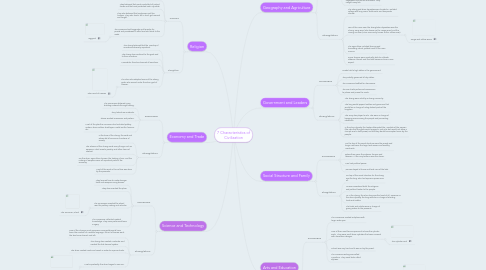
1. Religion
1.1. Sumerians
1.1.1. The Sumerians practiced Polytheism.
1.1.2. They believed that Gods controlled all natural forces and that God protected each city-state.
1.1.3. They also believed that Gods were just like humans. They ate, drank, fell in love, got married and fought.
1.1.4. The Sumerians built ziggurats and temples for priests and priestesses to offer food and drink to the Gods.
1.1.4.1. Ziggurat
1.2. Shang/Zhou
1.2.1. The Shang believed that the worship of ancestors extremely important.
1.2.2. The Shang also sacrificed to the gods and to their ancestors.
1.2.3. Meanwhile, the Zhou banned all sacrifices.
1.2.4. The Zhou also adapted some of the Shang gods, who served under the Zhou god of Heaven.
1.2.4.1. Zhou God of Heaven
2. Economy and Trade
2.1. Sumerians
2.1.1. The Sumerians obtained many building materials through trading.
2.1.2. They lacked raw materials.
2.1.3. Slaves worked as weavers and porters.
2.1.4. Most of the jobs the Sumerians had included pottery makers, stone cutters, bricklayers, metal smiths, farmers, etc.
2.2. Shang/Zhou
2.2.1. In the time of the Shang, the serfs and salves did all economic functions of society.
2.2.2. The artisans of the Shang made many things, such as weapons, ritual vessels, jewelry, and other items of interest.
2.2.3. For the Zhou, agriculture, bronze, the trading of iron, and the making of weapons were all important parts of the economy.
2.2.4. Most of the work in this culture was done by the peasants.
3. Science and Technology
3.1. Sumerians
3.1.1. They learned how to make stronger tools and weapons using bronze.
3.1.2. They also invented the plow.
3.1.3. The Sumerians invented the wheel used for pottery making and vehicles.
3.1.3.1. The Sumerian Wheel
3.1.4. The Sumerians collected medical knowledge. They even performed basic surgery.
3.2. Shang/Zhou
3.2.1. One of the Shang's most impressive accomplishments have been the creation of a written language, the art of bronze work, the two-horse chariot, and silk.
3.2.2. The Shang also created a calendar and created the first decimal system.
3.2.3. The Zhou created roads and canals in order to improve trade.
3.2.4. Most importantly, the Zhou began to use iron.
3.2.4.1. Iron from Zhou Dynasty
4. Geography and Agriculture
4.1. Sumerians
4.1.1. The Sumerians lived on the Tigris and Euphrates rivers. They lacked minerals and trees.
4.1.1.1. The Tigris and Euphrates Rivers
4.1.2. They learned core techniques such as organized irrigation and land cultivation.
4.1.3. They created structures out of mud brick.
4.1.4. The Sumerians also planted many vegetables like lettuce and wheat. They caught many fish.
4.2. Shang/Zhou
4.2.1. The Shang and Zhou dynasties were located in isolated valleys with long rivers, fertile soils, and temperate climate.
4.2.2. Two of the rivers near the Shang/Zhou dynasties were the Chang Jiang River (also known as the Yangzi River) and the Huang He River (more commonly known as the Yellow River).
4.2.2.1. Yangzi and Yellow Rivers
4.2.3. The agriculture included farming and harvesting, which yielded most of the main income.
4.2.4. Some farmers were eventually able to cultivate silkworm thread, and this later became China's main export.
5. Government and Leaders
5.1. Sumerians
5.1.1. Priests held a high status in the government.
5.1.2. They initially governed all city-states.
5.1.3. The Sumerians battled for dominance.
5.1.4. The war chiefs performed ceremonies to please and praise the Gods.
5.2. Shang/Zhou
5.2.1. The Shang were ruled by a strong monarchy.
5.2.2. The king would appoint nobles and governors that would be in charge of ruling distant parts of the kingdom.
5.2.3. The army also played a role. The were in charge of keeping peace among the people and preventing rebellions.
5.2.4. In the Zhou dynasty, the leaders fabricated the Mandate of the Heaven (the idea that the gods would support a just ruler but would not allow a corrupt one to hold power) so that they would be accepted more by the people.
6. Social Structure and Family
6.1. Sumerians
6.1.1. On the top of the social structure were the priests and kings, next were the large land owners and wealthy merchants.
6.1.2. Below them were the artisans, farmers and laborers. At the very bottom were the slaves.
6.1.3. Men had political power.
6.1.4. Women stayed at home and took care of the kids.
6.2. Shag/Zhou
6.2.1. On top of the social structure for the Shang was the king, who had supreme power over all.
6.2.2. He was considered both the religious and political leader to the people.
6.2.3. As in the Shang, the Zhou king was the head of all. However, in the Zhou dynasty, the king was also in charge of electing lords and nobles.
6.2.4. The lords and nobles were in charge of giving orders to the peasants.
7. Arts and Education
7.1. Sumerians
7.1.1. The Sumerians created sculptures with large, wide eyes.
7.1.2. One of their most famous pieces of art was the cylinder seals. They were small stone cylinders that were covered with decorative designs.
7.1.2.1. The Cylinder Seal
7.1.3. School was very hard and it was run by the priest.
7.1.4. The Sumerian writing was called cuneiform. They used tools called styluses.
7.2. Shang/Zhou
7.2.1. The Shang made vessels to give to the king as a form of tax payment or for religious rituals, such as worshipping ancestors.
7.2.1.1. Wine Vessel Used in Religious Rituals
7.2.2. Most likely, only the children of nobles were given formal schooling. Common children were probably given an apprenticeship in whatever they planned to do.
7.2.3. Zhou art was influenced by religious rituals and military instability.
7.2.4. The heir-sons and certain young men were taught of the use of the shield and spear in the spring and summer, and that of the feather and the flute in the fall and winter.
